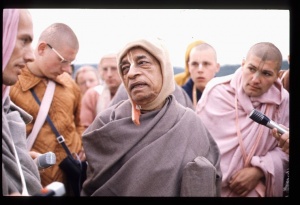CC Adi 5.84 (1975): Difference between revisions
(Vanibot #0027: CCMirror - Mirror CC's 1996 edition to form a basis for 1975) |
(Vanibot #0020: VersionCompareLinker - added a link to the Version Compare feature) |
||
| Line 2: | Line 2: | ||
<div style="float:left">'''[[Sri Caitanya-caritamrta (1975)|Śrī Caitanya-caritāmṛta (1975)]] - [[CC Adi (1975)|Ādi-līlā]] - [[CC Adi 5 (1975)|Chapter 5: The Glories Of Lord Nityānanda Balarāma]]'''</div> | <div style="float:left">'''[[Sri Caitanya-caritamrta (1975)|Śrī Caitanya-caritāmṛta (1975)]] - [[CC Adi (1975)|Ādi-līlā]] - [[CC Adi 5 (1975)|Chapter 5: The Glories Of Lord Nityānanda Balarāma]]'''</div> | ||
<div style="float:right">[[File:Go-previous.png|link=CC Adi 5.83 (1975)|Ādi-līlā 5.83]] '''[[CC Adi 5.83 (1975)|Ādi-līlā 5.83]] - [[CC Adi 5.85 (1975)|Ādi-līlā 5.85]]''' [[File:Go-next.png|link=CC Adi 5.85 (1975)|Ādi-līlā 5.85]]</div> | <div style="float:right">[[File:Go-previous.png|link=CC Adi 5.83 (1975)|Ādi-līlā 5.83]] '''[[CC Adi 5.83 (1975)|Ādi-līlā 5.83]] - [[CC Adi 5.85 (1975)|Ādi-līlā 5.85]]''' [[File:Go-next.png|link=CC Adi 5.85 (1975)|Ādi-līlā 5.85]]</div> | ||
{{CompareVersions|CC|Adi 5.84|CC 1975|CC 1996}} | |||
{{RandomImage}} | {{RandomImage}} | ||
==== TEXT 84 ==== | ==== TEXT 84 ==== | ||
| Line 27: | Line 26: | ||
<div class="translation"> | <div class="translation"> | ||
"In the beginning of the creation, the Lord expanded Himself in the form of the puruṣa incarnation, accompanied by all the ingredients of material creation. First He created the sixteen principal energies suitable for creation. This was for the purpose of manifesting the material universes." | |||
</div> | </div> | ||
| Line 34: | Line 33: | ||
<div class="purport"> | <div class="purport"> | ||
This is a verse from Śrīmad-Bhāgavatam ([[SB 1.3.1]]). The commentary of Madhva on Śrīmad-Bhāgavatam mentions that the following sixteen spiritual energies are present in the spiritual world: (1) śrī, (2) bhū, (3) līlā, (4) kānti, (5) kīrti, (6) tuṣṭi, (7) gīr, (8) puṣṭi, (9) satyā (10) jñānājñānā, (11) jayā utkarṣiṇī, (12) vimalā, (13) yogamāyā, (14) prahvī, (15) īśānā and (16) anugrahā. In his commentary on the Laghu-bhāgavatāmṛta, Śrī Baladeva Vidyābhūṣaṇa has said that the above energies are also known by nine names: (1) vimalā, (2) utkarṣiṇī (3) jñānā, (4) kriyā, (5) yogā, (6) prahvī, (7) satyā, (8) īśānā and (9) anugrahā. In the Bhagavat-sandarbha of Śrīla Jīva Gosvāmī ( | This is a verse from Śrīmad-Bhāgavatam ([[SB 1.3.1]]). The commentary of Madhva on Śrīmad-Bhāgavatam mentions that the following sixteen spiritual energies are present in the spiritual world: (1) śrī, (2) bhū, (3) līlā, (4) kānti, (5) kīrti, (6) tuṣṭi, (7) gīr, (8) puṣṭi, (9) satyā (10) jñānājñānā, (11) jayā utkarṣiṇī, (12) vimalā, (13) yogamāyā, (14) prahvī, (15) īśānā and (16) anugrahā. In his commentary on the Laghu-bhāgavatāmṛta, Śrī Baladeva Vidyābhūṣaṇa has said that the above energies are also known by nine names: (1) vimalā, (2) utkarṣiṇī (3) jñānā, (4) kriyā, (5) yogā, (6) prahvī, (7) satyā, (8) īśānā and (9) anugrahā. In the Bhagavat-sandarbha of Śrīla Jīva Gosvāmī (Anuccheda 103) they are described as śrī, puṣṭi, gīr, kānti, kīrti, tuṣṭi, ilā, jaya; vidyāvidyā, māyā, samvit, sandhinī, hlādinī, bhakti, mūrti, vimalā, yogā, prahvī, īśānā, anugrahā, etc. All these energies act in different spheres of the Lord's supremacy. | ||
</div> | </div> | ||
Latest revision as of 18:48, 26 January 2020

A.C. Bhaktivedanta Swami Prabhupada
TEXT 84
- jagṛhe pauruṣaṁ rūpaṁ
- bhagavān mahad-ādibhiḥ
- sambhūtaṁ ṣoḍaśa-kalam
- ādau loka-sisṛkṣayā
SYNONYMS
jagṛhe—accepted; pauruṣam—the puruṣa incarnation; rūpam—the form; bhagavān—the Supreme Personality of Godhead; mahat-ādibhiḥ—by the total material energy etc.; sambhūtam—created; ṣoḍaśa—sixteen; kalam—energies; ādau—originally; loka—the material worlds; sisṛkṣayā—with the desire to create.
TRANSLATION
"In the beginning of the creation, the Lord expanded Himself in the form of the puruṣa incarnation, accompanied by all the ingredients of material creation. First He created the sixteen principal energies suitable for creation. This was for the purpose of manifesting the material universes."
PURPORT
This is a verse from Śrīmad-Bhāgavatam (SB 1.3.1). The commentary of Madhva on Śrīmad-Bhāgavatam mentions that the following sixteen spiritual energies are present in the spiritual world: (1) śrī, (2) bhū, (3) līlā, (4) kānti, (5) kīrti, (6) tuṣṭi, (7) gīr, (8) puṣṭi, (9) satyā (10) jñānājñānā, (11) jayā utkarṣiṇī, (12) vimalā, (13) yogamāyā, (14) prahvī, (15) īśānā and (16) anugrahā. In his commentary on the Laghu-bhāgavatāmṛta, Śrī Baladeva Vidyābhūṣaṇa has said that the above energies are also known by nine names: (1) vimalā, (2) utkarṣiṇī (3) jñānā, (4) kriyā, (5) yogā, (6) prahvī, (7) satyā, (8) īśānā and (9) anugrahā. In the Bhagavat-sandarbha of Śrīla Jīva Gosvāmī (Anuccheda 103) they are described as śrī, puṣṭi, gīr, kānti, kīrti, tuṣṭi, ilā, jaya; vidyāvidyā, māyā, samvit, sandhinī, hlādinī, bhakti, mūrti, vimalā, yogā, prahvī, īśānā, anugrahā, etc. All these energies act in different spheres of the Lord's supremacy.